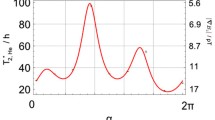Abstract
Precession of aligned nuclear spin systems in ions recoiling from the target into vacuum (RIV) with consequent attenuation of angular distributions of emitted radiation is, in principle, a versatile method for measurement of g-factors of nuclear excited states of lifetimes in the pico-second range (Stone et al., Phys. Rev. Lett., 94, 192501, 2005 and Stuchbery and Stone, Phys. Rev. C, 76, 034307, 2007). Calibration of the observed attenuations has been achieved in favourable cases through comparison with measurements on states having previously known g-factors and lifetimes. The general lack of suitable states with known g-factors has limited application of the RIV method. This paper concerns the present status of efforts to describe the states of excited ions recoiling into vacuum in detail so that the average interaction can be estimated with useful precision from a-priori theory. The calculations use the GRASP2K package (Froese-Fischer et al. 1997 and Jonsson, Comp. Phys. Comm., 177, 597, 2007 & 184, 2197, 2013) to obtain, for each recoiling ion change state, the individual possible electronic states, their configurations, lifetimes and hyperfine interactions. It is assumed that all possible ionic states are produced, up to a chosen excitation energy. This energy is selected to approximate the energy at which all states have lifetimes far shorter than the nuclear state of interest. It is further assumed that the ionic state total electron angular momenta are randomly oriented in space. The first estimates of the average attenuation of emission distributions, as a function of the product g τ of the nuclear state g-factor and mean lifetime, used an averaged precession frequency obtained neglecting transitions between electronic states. Improved calculations, which include such transitions, are described.
Similar content being viewed by others
References
Stone, N.J. et al.: Phys. Rev. Lett. 94, 192501 (2005)
Stuchbery, A.E., Stone, N.J.: Phys. Rev. C 76, 034307 (2007)
Froese-Fischer, C., Brage, T., Jonsson, P.: Computational Atomic Structure. IoP, London (1997)
Jonsson, P. et al.: Comp. Phys. Comm. 177, 597 (2007)
Jonsson, P. et al.: Comp. Phys. Comm. 184, 2197 (2013)
Benczer-Koller, N., Kumbartzki, G.J.: J. Phys. G.: Nucl. Part. Phys. 34, R321 (2007)
Frauenfelder, H., Steffen, R.: Perturbed Angular Correlations. Amsterdam, North Holland (1964)
Stone, N.J., Stone, J.R., Jonsson, P.: Hyperfine Interactions 197, 29 (2010)
Chen, X., Saratites, D.G., Reviol, W., Snyder, J.: Phys. Rev. C 87, 044305 (2013)
Stuchbery, A.E.: Hyperfine Interactions 220, 29 (2013)
Author information
Authors and Affiliations
Corresponding author
Additional information
Proceedings of the 5th Joint International Conference on Hyperfine Interactions and International Symposium on Nuclear Quadrupole Interactions (HFI/NQI 2014) Canberra, Australia, 21–26 September 2014
Rights and permissions
About this article
Cite this article
Stone, N.J., Stone, J.R., Stuchbery, A.E. et al. Calibration of Recoil-In-Vacuum attenuations from first principles: comparison with recent experimental data on Fe isotopes. Hyperfine Interact 230, 169–174 (2015). https://doi.org/10.1007/s10751-014-1110-z
Published:
Issue Date:
DOI: https://doi.org/10.1007/s10751-014-1110-z




